



 |
 |
 |
 |
|
|
|
|
|
Noticable
plants of the upper meadows include Greater
Knapweed, Hardheads (=Lesser Knapweed),
Field
Scabious, Meadow Cranesbill, Alexanders,
Pyramidal
Orchids,
Yarrow, Eyebrights,
Musk
Thistles,
Sweet
Violets, Horseshoe
Vetch and
many others.
Some
Indicator Plants of Ancient Downland (Link)
| OVERVIEW:
The original historic reports state that originally a large part* of the downs including Mill Hill were presented to the people of Shoreham in 1938. (* The amount is still under enquiry.) Just over 30 acres still remain as public open land. This is divided into about 11 acres of grassland and meadows above the ridge, about 9 acres of scrub, the copse and glades at the northern end, and about half of the prime Chalkhill Blue area of 6.4 acres of herbland remaining. 6 acres has been lost to a Sycamore woodland on the southern slopes. This is low fertility chalkland not suitable for grazing. The top area is effectively a wild meadow and the lower slopes a rabbit warren dominated by prostrate (not the upright form) Horseshoe Vetch. |
|
||||
| Chalkhill Blues:
Mill Hill
is nationally important because of its population of Chalkhill
Blue Butterflies. Estimates of the numbers
are notoriously inaccurate. In the 1950s the population was estimated by
R. M. Craske to be 50,000. This may be an
exceptionally good year. I would estimate the numbers at that time to be
nearer 25,000 for Mill Hill only. After the cattle grazing and thorn incursions
the numbers plummeted to the most reliable estimate in 1960 of 6,000. The
new road and Sycamore woodland further denuded the Horseshoe
Vetch and bare chalk downland to a figure
I have estimated at a top figure of 3,000 Chalkhill Blue Butterflies at
the turn of the millennium (counted in 2003). Almost all these butterflies
are now to be found on the six acres of the lower slopes.
Text
by Andy Horton
|

 |
||||
| "Our family
lived at The Mill House, Mill Hill, from around 1933 until about 1967,
and every July we saw the "Butterfly Men" walking past onto the
Downs. My father used to tell us that they were interested in the blue
butterflies."
Heather
Clark (née Eager), Ryde, Isle of Wight
|
20
June 2006
The
first Marbled White Butterfly
of the year fluttered strongly over the
lower
slopes of Mill Hill where the Horseshoe
Vetch flowers had almost disappeared and the
corkscrew-like seed pods could be discovered if searched amongst the emerging
herbs and new flowers. The largest yellow
patches on Mill Hill were now Bird's Foot
Trefoil. Butterflies
were frequent (about 50), but not common. The most prevalent on Mill Hill
were now Common Blues
and Small Heath Butterflies
with about 15 each.
The
hoverfly
Rhingia campestris
fed on Greater
Knapweed on the middle Triangle
area of Mill Hill. It was breezy at the top of the hill. Smooth
Sow-thistle, Sonchus oleraceus, was
recorded in the copse at the top of Mill
Hill.
Butterfly
Report & List
Adur
Butterfly First Flight Times
 15
June 2006
15
June 2006
With
wild
flowers bursting into flower everywhere, the highlight was about a
hundred Bee Orchids
in Mill Hill Drive. There was one Kidney
Vetch flower seen on the Triangle
section of Mill Hill. The first Greater
Knapweed was seen in flower and Field
Scabious.
About
half of the 25 Adonis Blue Butterflies
on Mill Hill showed signs of raggedness
and age, whereas the Common Blues
appeared fresher. I spotted my first
Meadow
Brown
Butterfly of the year on the lower
slopes, where I was surprised at a settled late Grizzled
Skipper and I had a better look at a Large
Skipper.
There
were eleven different species in an hour.
Full
Butterfly Report
A
Silver
Y Moth, a Burnet
Companion, a Treble-Bar
and two pretty Mother Shiptons, Callistege
mi, were all seen on Mill Hill.
A
Skylark
rose into the air.
12
June 2006
The
first Meadow Brown
Butterfly of the year was seen on Mill
Hill. Other butterflies seen were Dingy
Skipper (1), Small
Heath (10), Adonis
Blue (many,
including several egg laying females), Common
Blue (20), Brimstone
(2), Small
White (4), Painted
Lady (1).
11
June 2006
Amongst
the long grass meadow north of the top car park on Mill Hill, I had a brief
sight of my first Large Skipper
of the year (the only skipper of the day).
I did not get a good a look as I would have liked to identify it, but Large
Skippers precede the Small
Skippers, so that is what it was. Adonis
Blues (45
to 53 +) were
most numerous on the lower slopes and the other species recorded were Common
Blue, Large White,
Speckled
Wood (6), Holly Blue, Red
Admiral
and
Small
Heath (8).
Eight
species.
Adur
Butterfly First Flight Times
Butterfly
Report (all sites)
Near the reservoir a group of five Magpies followed by a sixth were making a tremendous chattering racket.
On
the lower slopes the Horseshoe Vetch
had diminished considerably (it could not be seen from a distance), but
the later growths on the middle and upper slopes showed patches even amongst
the long grass with a handful of Adonis Blue
Butterflies.
| 29
May 2006
The Old Erringham pastures were examined for their flora. It was quite different from Mill Hill with a higher proportion of grasses, but with a selection of herbs (excluding grasses), especially noting that the dramatic explosion of Bulbous Buttercups, with the blue Milkwort doing very well, and both Horseshoe Vetch and Bird's Foot Trefoil noted in small amounts. Images 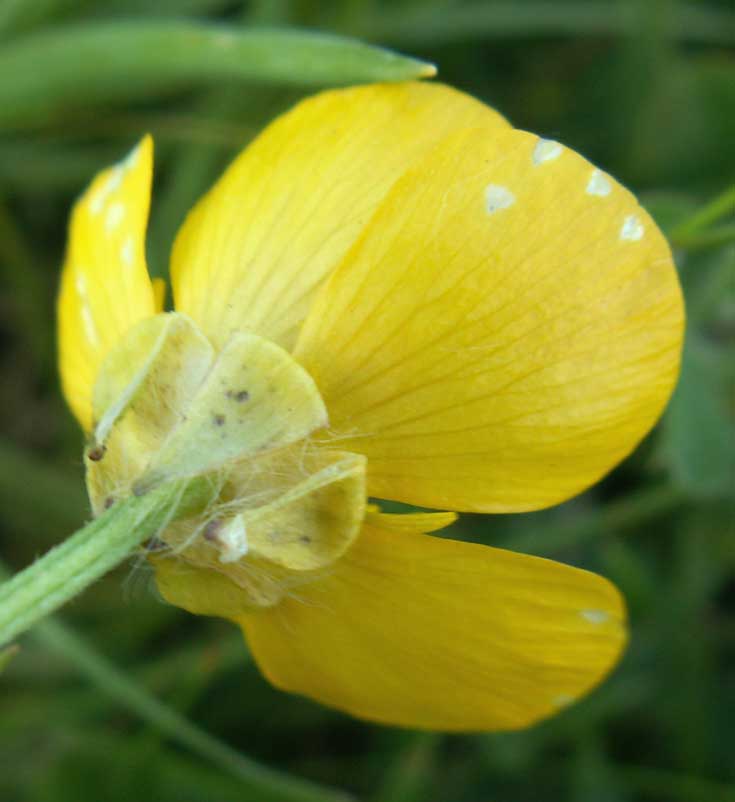 Adur
Buttercups Adur
Buttercups |
 |
 |
 |
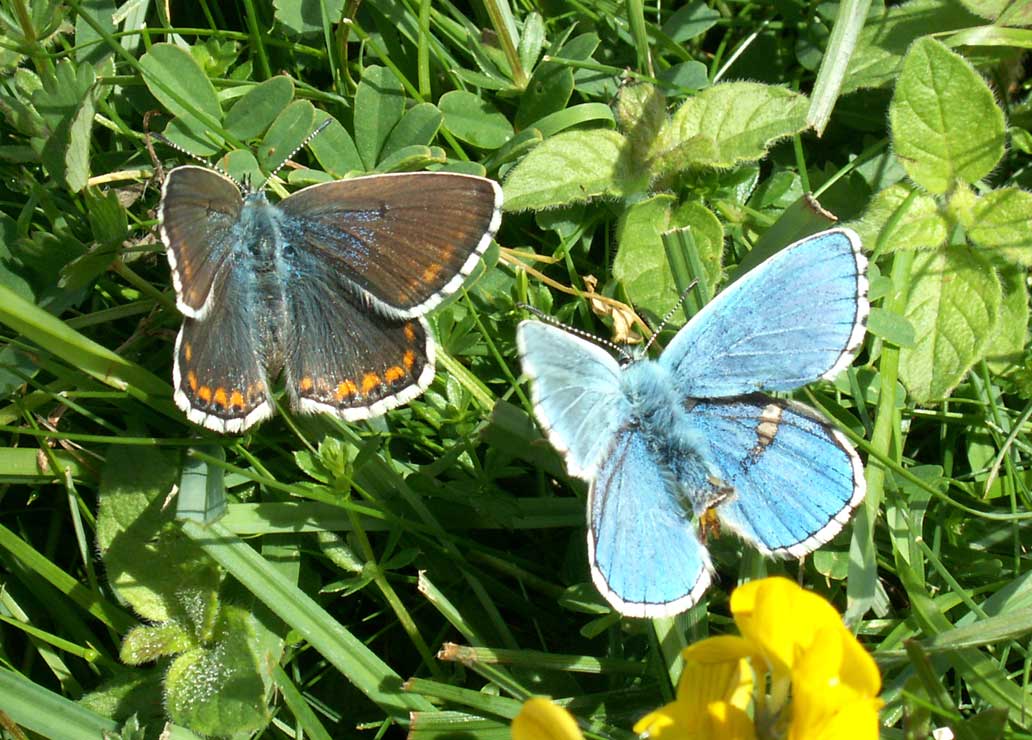 |
 |
The
prostrate
Horseshoe Vetch was prevalent
on the lower slopes, at about 70% of its luxuriance. Some flowers have
not yet opened and it has appeared at the northern end which it usually
does first, and has not yet appeared very much on the steeper banks, which
are always a week later. In the Triangle area
the Horseshoe Vetch was sparser than normal and on the upper plateau it
was not prominent and was not instantly visible. Surprisingly there were
some small patches of Horseshoe Vetch lost amongst the superabundant
Bulbous
Buttercups and a handful of patches of
Milkworts
in the Old Erringham pasture
to the north-west of Mill Hill Nature Reserve.
Also, in the meadow north of the upper car
park, an erect variety of Horseshoe Vetch
was spotted amongst the long grasses with a longer stalk (over 30 cm high,
but still lower than the sward) and less leaves than the plant on the lower
slopes. Summary: the Horseshoe Vetch is flowering
over a week later than the last two years.
 |
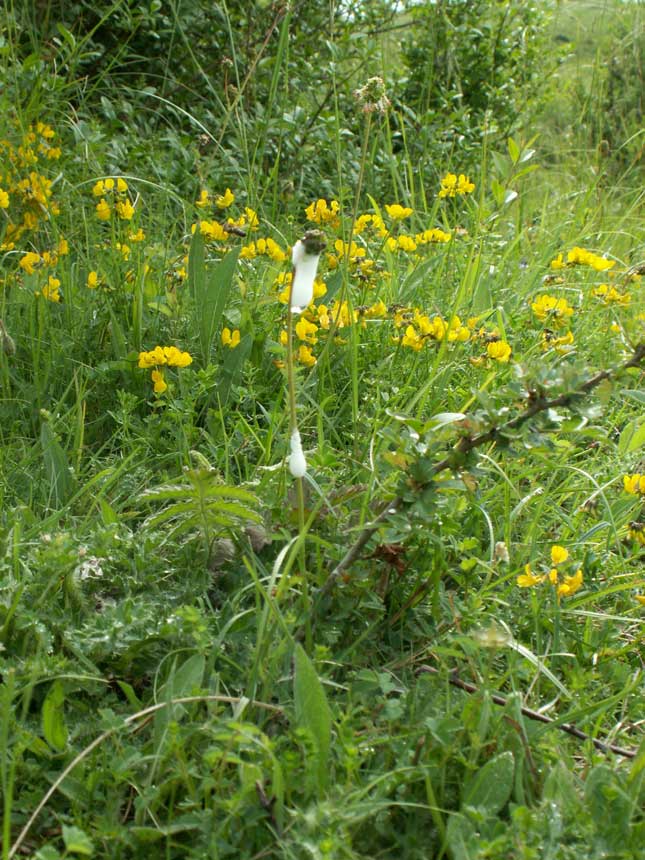 |
 |
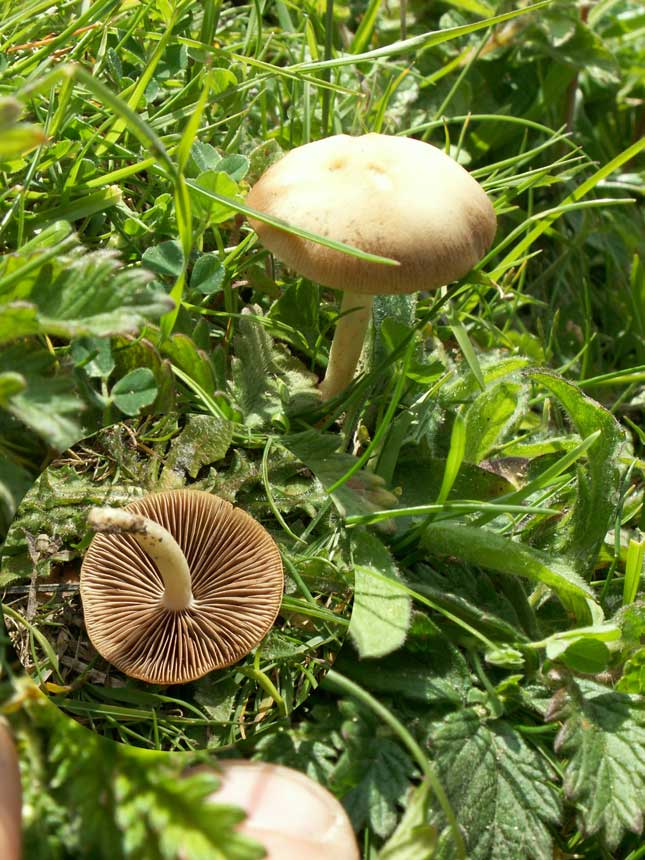 |
I traversed
the meadows around the upper car park and I did not note any butterflies
although a Small Heath Butterfly
was seen in the short sward near the reservoir. There were a few flying
insects illustrated above in the dense meadows and at least one mushroom
was noted in the short turf. The wasp mimic
is a hoverfly, a species of Chrysotoxum.
| 21
May 2006
Three Swifts were seen (from southern car park of Mill Hill) flying over Frampton's Field before the cloud descended and obscured visibility and turned into steady rain that continued for the rest of the daylight. Image: Alexanders and Cow Parsley on the southern part of Mill Hill Nature Reserve |
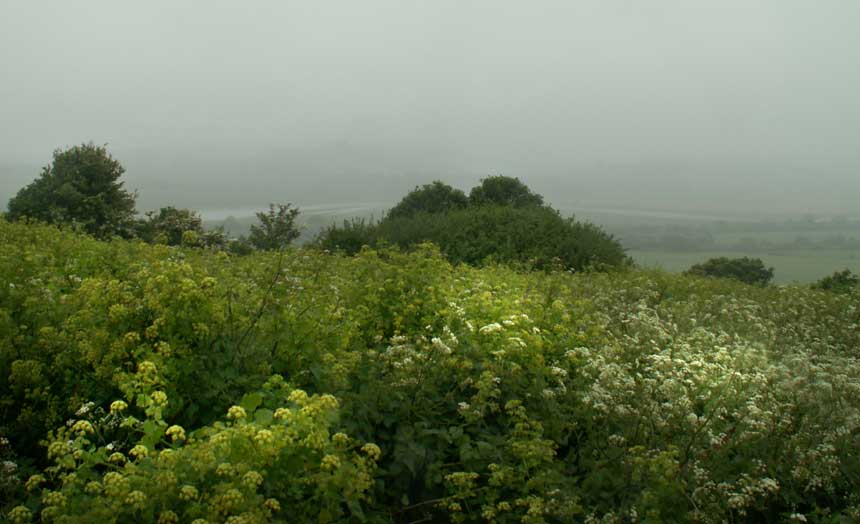 |
15
May 2006
My
first two Silver Y Moths
of the year flew from Frampton's Field,
Old Shoreham. My first two Wall Brown Butterflies
and my first Brimstone Moth
were seen on a brief visit to Mill Hill. Two Partridges
took flight from the Old Erringham buttercup-strewn pastures immediately
to the north-west of Mill Hill. Silverweed
was flowering on Mill Hill. The leaves
of the Greater Knapweed were everywhere.
Full
Butterfly Report
 14
May 2006
14
May 2006
An
attractive Eyed Hawk-moth, Smerinthus
ocellata, was discovered on a Daffodil
in
my garden in Mill Hill Gardens, which was at one time part of Mill Hill.
At
10:00
am the resident Kestrel
hovered in the overcast sky before the start of the Butterfly
Walk on the lower
slopes of Mill Hill which produced just two Small
Heath Butterflies and a handful of small
Pyrausta
nigrata moths.The Horseshoe
Vetch was just beginning, only about 5%
of its full splendour. The sun struggled to come out in the afternoon and
I recorded my first male Adonis Blue Butterfly
of the year on the Shoreham Bank with
13
Dingy
Skippers, five Grizzled
Skippers and three Small
Heath Butterflies.
Full
Butterfly Report
Adur
Butterfly First Flight Times
|
A note was made of the Brown-tailed Moth caterpillars in their silk cocoons. The caterpillars seem to strip the upper leaves completely (in the one example noted) but most of the Hawthorn is still in leaf and not stripped bare. In the nearby Hawthorn without caterpillars, no damage can be seen. On the lower slopes the number of small moths were notable with both Pyrausta nigrata and Pancalia being common (over 100 each). Five each of Dingy Skippers and Grizzled Skippers were recorded with a Peacock Butterfly and a Large White Butterfly. |
 |
1 May
2006
May
came in with a shower. On the lower
slopes of Mill Hill, the first Milkwort
was seen in flower and the exiguous beginnings of the Horseshoe
Vetch, Hippocrepis comosa.
A single first Grizzled Skipper
was recorded, the first of the year, with frequent (10+) small moths
Pyrausta nigrata, seen for the first
time this year,
26
April 2006
A
Partridge
whirred into flight on Erringham Hill as a Kestrel
cruised overhead. South of the upper car park, a Rook
probed the ground as a Skylark
rose vertically and started singing until it was just a speck in the blue
and white cirrus sky.
At
the northern end of the lower slopes I
spotted my first Dingy Skipper
of the year that briefly sparred with a Peacock
and the size difference was most noticeable. The Dingy
Skipper is the first of I have heard of anywhere
this year. A few Sweet Violets
still flowered under the shade of the Hawthorn, but it was mostly Dog
Violets in
the open.
Adur
Violets
24
April 2006
Half
a dozen silken nests of the Brown-tailed
Moths were noticed on Hawthorn trees on
the southern part of Mill Hill.
19
April 2006
 |
This
attractive bee seen on the lower
slopes of Mill Hill was the first time the Tawny
Mining Bee, Andrena
fulva, has been recorded on these
Nature
Notes pages. It is a female. The species
is common and widespread.
Report
and Photograph
by
Ray Hamblett
(Lancing Nature)
ID by
Nicolas
J. Vereecken on the Bees, Wasps and Ants Recording Society (Yahoo Group)
on the Bees, Wasps and Ants Recording Society (Yahoo Group) |
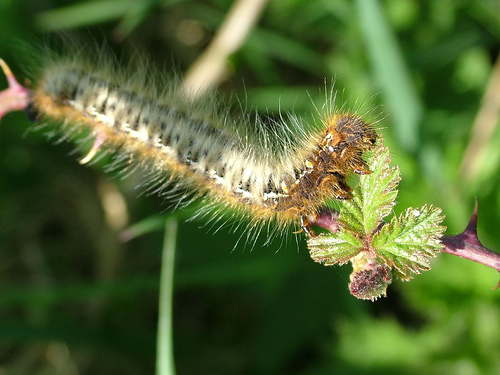 |
There
were many silk Brown-tailed Moth nests
on Brambles at
Mill
Hill, Shoreham and a caterpillar noted and shown the photograph. The
caterpillar was not connected to the silk nests and has been identified
as an Oak Eggar Moth, Lasiocampa
quercus, caterpillar (which
does not associate with Oak).
|
18
April 2006
Amongst
the plants noted first in flower today were Dog
Violets and Cowslips
on the lower slopes of Mill Hill. But
it was a remaining
Sweet Violet
that attracted a Peacock Butterfly.
Butterfly
Report
9 April
2006
My
first Swallow
of the year flew low over the brow of Mill Hill and followed the country
road northwards. Other Swallows
had been seen by others in Sussex
late in March.
 6
April 2006
6
April 2006
At
last the first butterflies were seen on the
lower
slopes of Mill Hill: two definite
Peacock
Butterflies and at least one Comma
Butterfly nectaring on the thousands of
Sweet
Violets in flower. There was a probable
Small
Tortoiseshell Butterfly as well.
Full
Butterfly Report
A solitary
Dotted
Bee-fly,
Bombylius
discolor,
a declining BAP species, was seen on a path
through the scrub in the north-west and
a tiny bee
on a Daisy. This
is the first time this fly has been recorded on the downs north of Shoreham.
Dotted
Bee-fly (More Information)
Adur
Flies 2006
Adur
Solitary Bees
22
March 2006
Spring
is imminent. There were Sweet Violets
in flower one the slope by the most southerly seat on the southern section
of the upper part of Mill Hill. These violets have large leaves. Then there
were hundreds over the lower slopes of
Mill Hill. These later violets have exiguous leaves. However, none of these
violets
were seen on the middle slopes in the Triangle
area yet. The red stems of Dogwood
were prominent. This woody scrub plant is the main incursor on the upper
part of Mill Hill.
Adur
Violets
2 March
2006
I
surprised a female Sparrowhawk
perched on a branch in the spinney between the top plateau of Chanctonbury
Drive (SE of the bridge over the A27 to Mill Hill) and the A27. This is
on the edge of the Mill Hill Cutting.
I got as close as two metres before the raptor flew off, but it was well
camouflaged and it was not until I was three metres from it, did I see
the bird of prey at all. It was much bigger with marked hooded eyes than
the familar Kestrel and
I estimated its height at 40 cm. This is much
larger than the book size of the male which is only record to 30 cm.
17
February 2006
A
flock
of sheep are on the private agricultural hay
meadow to the west of Mill Hill feeding on the stubble and grass as is
usual for short periods in the winter.
There
was absolutely not the remotest sign of the Sweet
Violet clump flowering on the southern slopes
of Mill Hill.
Adur
Violets
1 February
2006
The
cattle
have been removed from the "lambing field" or intermittent pasture to the
south-east of Old Erringham Farm and will not now venture on to Mill Hill.
This is probably because the grass on the land has now been grazed to its
optimum and is best left for the spring growth. This pasture is of no butterfly
value although the fringes may contain the occasional wild flower.
January
Cattle Report
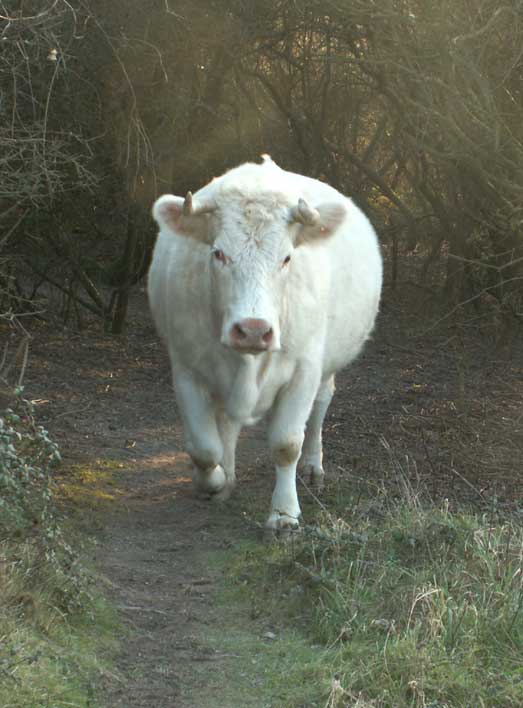 30
January 2006
30
January 2006
There
are cattle
all over Mill Hill from Old Erringham Farm enriching the low nutrient hillsides
with their dung and threatening the flora (Horseshoe
Vetch) and the internationally important
population of Chalkhill Blue Butterflies.
It looks like the fence was broken down deliberately, probably at the instigation
of the South Downs Conservation Board
on public land given to the people of Shoreham.
There is also the danger or erosion, breaking up the steps under the hooves
of the cattle and reduction of the amenity value of the downs. They were
timid cattle and they were shooed of the vulnerable lower
slopes by the public. Most of the dung
was on the steps near the stile in the north-west
corner of Mill Hill Nature Reserve.
First
Draft of the Article for the Shoreham Society Newsletter
18
January 2006
There
were a couple of House Sparrows
next to a small eight caravan illegal encampment in the upper car park
of Mill Hill which are unusual for this area. On the pastures to the east
of Mill Hill a handful each of Rooks
and Magpies
were forgaging and on Mill Hill there were a few Crows.
It is muddy under foot when human feet had trampled, with squelchy bits
and puddles.
 |
 |
 |
 |
 |
One tree on the upper slopes sported at least four of the common local lichens.
13
January 2006
My
first visit of the year in the afternoon to the southern area and lower
slopes of Mill Hill failed to find anything remotely newsworthy. The
lower slopes looked more grassy than normal after the rain and there was
still discarded chopped down Privet
laying about. The remains of Carline Thistle
were showing and the scrub was adorned by the straggly remains of Clematis.
There was a discarded mushroom, which was probably Honey
Fungus.
Pixie
Path to Mill Hill (Link)
Mill
Hill Wildlife Reports 2005 (Link)
LINK TO THE WILDLIFE REPORTS FOR AUTUMN - SUMMER 2004
LINK TO THE MILL HILL WILDLIFE REPORTS FOR WINTER & SPRING 2004
| Chalkhill
Blue (3000 +)
Adonis Blue (50 -100) Dingy Skipper (75) |
Small
Heath (250)
Wall Brown (12) Meadow Brown (300) |
Marbled White (50)
Gatekeeper (200) Speckled Wood (>50) Green-veined White (2+) |
Common
Blue (>3000+)
Small Blue (5) Brimstone (8) |
Small
Skipper (>50)
Large Skipper (10+) Grizzled Skipper (20) Brown Argus (>30) |
The other species may breed on Mill Hill, but there main breeding area will be adjoining fields or slightly further away. e.g. Small Blue (included above), Small Copper, Small Tortoiseshell, Green-veined White, Peacock, Ringlet, Small White, Large White, Comma, Holly Blue, Orange Tip. (=10)
The following are immigrants &/or hibernators: Red Admiral, Painted Lady, Clouded Yellow.
The following have not been positively identified (because of ID difficulties): Essex Skipper. This species is now included for a local field on the Adur Levels within 500 metres of Mill Hill.
(=30)
The
following may occur but it has not been positively identified (because
it is elusive and hard to spot): Green Hairstreak.
The next one is no longer
found on Mill Hill but were there in the recent (reduced drastically to
almost extinct by 1948 last record in 1968) past: Dark
Green Fritillary (Records of this butterfly
in 1857, 1938, and 1945 when it was common.)
The next one is no longer
found on Mill Hill but were there in the distant (1947) past: Grayling.
The next one has been recorded
near Mill Hill in the middle distance past: White-letter
Hairstreak
(=34)
The
Silver-spotted
Skipper does not appear to ever have occurred
on Mill Hill
The
Silver-studded
Blue has never been recorded from Mill Hill
The
Short-tailed
Blue was recorded as a single immigrant in
1956.
Link
to the Mill Hill WILDLIFE REPORTS up to 2003
with
lots of Butterfly observations
Lower Slopes (with Butterfly Reports)
Mill Hill Nature Reserve (including map)
MultiMap Aerial Photograph of Mill Hill
Back
to Mill Hill
Triangle
Upper
Slopes
Middle
Slopes
Lower
Slopes
Grasses
of Mill Hill
Mill
Hill Copse
Aerial
Map
Lower
Adur Levels (MultiMap) including Lancing Clump and Mill Hill
Hippocrepis
comosa (Horseshoe Vetch)
First
Draft of the Article for the Shoreham Society Newsletter